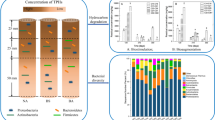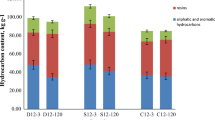Abstract
Large petrochemical discharges are responsible for organic and inorganic pollutants in the environment. The purpose of this study was to evaluate the influence of nickel, one of the most abundant inorganic element in crude oil and the main component of hydrogen catalysts for oil refining, on the microbial community structure in artificially petroleum-contaminated microcosms and in solid phase bioreactor studies. In the presence of metals, the oil biodegradation in microcosms was significantly delayed during the first 7 days of operation. Also, increasing amounts of moisture generated a positive influence on the biodegradation processes. The oil concentration, exhibiting the most negative influence at the end of the treatment period. Molecular fingerprinting analyses (denaturing gradient gel electrophoresis—DGGE) indicated that the inclusion of nickel into the contaminated soil promoted direct changes to the microbial community structure. By the end of the experiments, the results of the total petroleum hydrocarbons removal in the bioreactor and the microcosm were similar, but reductions in the treatment times were observed with the bioreactor experiments. An analysis of the microbial community structure by DGGE using various markers showed distinct behaviors between two treatments containing high nickel concentrations. The main conclusion of this study was that Nickel promotes a significant delay in oil biodegradation, despite having only a minor effect over the microbial community.





Similar content being viewed by others
References
Adesodun JK, Mbagwu JSC (2008) Distribution of heavy metals and hydrocarbon contents in an alfisol contaminated with waste-lubricating oil amended with organic wastes. Bioresour Technol 99:3195–3204. doi:10.1016/j.biortech.2007.05.048
Alisi C, Musella R, Tasso F et al (2009) Bioremediation of diesel oil in a co-contaminated soil by bioaugmentation with a microbial formula tailored with native strains selected for heavy metals resistance. Sci Total Environ 407:3024–3032. doi:10.1016/j.scitotenv.2009.01.011
Almeida R, Mucha AP, Teixeira C et al (2013) Biodegradation of petroleum hydrocarbons in estuarine sediments: metal influence. Biodegradation 24:111–123. doi:10.1007/s10532-012-9562-9
Amado-Filho G, Salgado L, Rebelo M et al (2008) Heavy metals in benthic organisms from Todos os Santos Bay, Brazil. Braz J Biol 68:95–100
Amor L, Kennes C, Veiga MC (2001) Kinetics of inhibition in the biodegradation of monoaromatic hydrocarbons in presence of heavy metals. Bioresour Technol 78:181–185
Atagana HI (2010) Bioremediation of Co-contamination of Crude oil and heavy metals in soil by phytoremediation using Chromolaena odorata (L) King & H.E. Robinson. Water Air Soil Pollut 215:261–271. doi:10.1007/s11270-010-0476-z
Biasioli M, Barberis R, Ajmone-Marsan F (2006) The influence of a large city on some soil properties and metals content. Sci Total Environ 356:154–164. doi:10.1016/j.scitotenv.2005.04.033
Clarke KR (1993) Non-parametric multivariate analyses of changes in community structure. Aust J Ecol 18:117–143. doi:10.1111/j.1442-9993.1993.tb00438.x
Cunha CD (2004) Avaliação de diferentes tecnologias de biorremediação de água subterrânea contaminada com gasolina e análise molecular da comunidade bacteriana presente. 176
Dermont G, Bergeron M, Mercier G, Richer-Laflèche M (2008) Metal-contaminated soils: remediation practices and treatment technologies. Pract Period Hazardous Toxic Radioact Waste Manag 12:188. doi:10.1061/(ASCE)1090-025X(2008)12:3(188)
Dobler R, Saner M, Bachofen R (2000) Population changes of soil microbial communities induced by hydrocarbon and heavy metal contamination. Bioremediat J 4:41–56. doi:10.1080/10588330008951131
Galvez-Cloutier R, Dube JS (2002) Impact of residual NAPL on water flow and heavy metal transfer in a multimodal grain size soil under saturation conditions: Implications for contaminant mobility. ASTM Spec Tech Publ 126–137
Gillespie IMM, Philp JC (2013) Bioremediation, an environmental remediation technology for the bioeconomy. Trends Biotechnol 31:329–332. doi:10.1016/j.tibtech.2013.01.015
Gomes NCM, Heuer H, Schönfeld J et al (2001) Bacterial diversity of the rhizosphere of maize (Zea mays) grown in tropical soil studied by temperature gradient gel electrophoresis. 167–180
Hammer Ø, Harper DAT, Ryan PD (2001) PAST: paleontological statistics software package for education and data analysis. Paleontol Electrón 4:1–9
Heuer H, Krsek M, Baker P et al (1997) Analysis of actinomycete communities by specific amplification of genes encoding 16S rRNA and gel-electrophoretic separation in denaturing gradients. Appl Environ Microbiol 63:3233–3241
Ke L, Luo L, Wang P et al (2010) Effects of metals on biosorption and biodegradation of mixed polycyclic aromatic hydrocarbons by a freshwater green alga Selenastrum capricornutum. Bioresour Technol 101:6961–6972. doi:10.1016/j.biortech.2010.04.011
Knox EG, Gilman E (1997) Hazard proximities of childhood cancers in Great Britain from 1953-80. J Epidemiol Community Health 51:151–159
Kozdrój J, van Elsas JD (2001) Structural diversity of microorganisms in chemically perturbed soil assessed by molecular and cytochemical approaches. J Microbiol Methods 43:197–212
Kratochvil D, Volesky B (1998) Advances in the biosorption of heavy metals. Trends Biotechnol 16:291–300
Ledin M, Pedersen K (1996) The environmental impact of mine wastes—roles of microorganisms and their significance in treatment of mine wastes 41:67–108
Maila M, Cloete T (2005) The use of biological activities to monitor the removal of fuel contaminants—perspective for monitoring hydrocarbon contamination: a review. Int Biodeterior Biodegrad 55:1–8. doi:10.1016/j.ibiod.2004.10.003
Maliszewska-Kordybach B, Smreczak B (2003) Habitat function of agricultural soils as affected by heavy metals and polycyclic aromatic hydrocarbons contamination. Environ Int 28:719–728. doi:10.1016/S0160-4120(02)00117-4
Mühling M, Woolven-Allen J, Murrell JC, Joint I (2008) Improved group-specific PCR primers for denaturing gradient gel electrophoresis analysis of the genetic diversity of complex microbial communities. ISME J 2:379–392. doi:10.1038/ismej.2007.97
Nadal M, Schuhmacher M, Domingo JL (2007) Levels of metals, PCBs, PCNs and PAHs in soils of a highly industrialized chemical/petrochemical area: temporal trend. Chemosphere 66:267–276. doi:10.1016/j.chemosphere.2006.05.020
Oyetibo GO, Ilori MO, Obayori OS, Amund OO (2013) Biodegradation of petroleum hydrocarbons in the presence of nickel and cobalt. J Basic Microbiol. doi:10.1002/jobm.201200151
Rizzo ACDL, dos Santos RDM, dos Santos RLC et al (2010) Petroleum-contaminated soil remediation in a new solid phase bioreactor. J Chem Technol Biotechnol 85:1260–1267. doi:10.1002/jctb.2425
Roelofsen A, Boon WPC, Kloet RR, Broerse JEW (2011) Stakeholder interaction within research consortia on emerging technologies: learning how and what ? Res Policy 40:341–354. doi:10.1016/j.respol.2010.10.015
Sambrook J, Russell DW (2001) Molecular cloning: a laboratory manual, 3rd edn. Cold Spring Harbor Laboratory Press, New York
USEPA (1996) Cleaning up the nation’s waste sites: markets and technology trends, 1996 edition. Washington, DC
USEPA (2004) Cleaning up the nation’s waste sites: markets and technology trends, 4th edn. Washington, DC
Van Hamme JD, Singh A, Ward OP (2003) Recent advances in petroleum microbiology. Microbiol Mol Biol Rev 67:503–549. doi:10.1128/MMBR.67.4.503
Volesky B, Holan ZR (1995) Biosorption of heavy metals. Biotechnol Prog 11:235–250. doi:10.1021/bp00033a001
Wang J, Chen C (2009) Biosorbents for heavy metals removal and their future. Biotechnol Adv 27:195–226. doi:10.1016/j.biotechadv.2008.11.002
Watanabe K, Hamamura N (2003) Molecular and physiological approaches to understanding the ecology of pollutant degradation. Curr Opin Biotechnol 14:289–295. doi:10.1016/S0958-1669(03)00059-4
Acknowledgments
We would like to express our appreciation to the Ministry of Science Technology and Innovation (MCTI) for the infrastructure support and Adriana Ururahy Soriano from Petrobras for technical support.
Author information
Authors and Affiliations
Corresponding author
Electronic supplementary material
Below is the link to the electronic supplementary material.
Rights and permissions
About this article
Cite this article
Taketani, N.F., Taketani, R.G., Leite, S.G.F. et al. The influence of nickel on the bioremediation of multi-component contaminated tropical soil: microcosm and batch bioreactor studies. World J Microbiol Biotechnol 31, 1127–1135 (2015). https://doi.org/10.1007/s11274-015-1862-x
Received:
Accepted:
Published:
Issue Date:
DOI: https://doi.org/10.1007/s11274-015-1862-x




